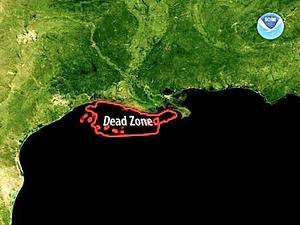Gulf of Mexico oil spillLargest-ever Gulf dead zone spans from Galveston to Mississippi River
The dead zone off the Texas coast is larger this year than scientists have ever measured, stretching offshore from the Mississippi River to Galveston Island; fish and shellfish often can swim away from these areas but immobile organisms, such as clams, simply die without access to oxygen

The oxygen-poor "dead zone" off the Gulf coast, approximation by NOAA // Source: sciencedaily.com
The dead zone off the Texas coast is larger this year than scientists have ever measured, stretching offshore from the Mississippi River to Galveston Island. An area of low-oxygen water that threatens marine life, the dead zone is at its largest during the summer months.
“This is the largest such area off the upper Texas coast that we have found since we began this work in 1985.”
Houston Chronicle’s Eric Berger writes that discharge from the Mississippi River, which carries nitrogen and phosphorous nutrients from Midwestern states, largely creates the dead zone. These nutrients, partly from commercial fertilizers, spur the growth of algaeblooms which, after dying, sink to the bottom. There the bacteria which feast upon the algae also bloom, depleting oxygen in the water.
Fish and shellfish often can swim away from these areas but immobile organisms, such as clams, simply die without access to oxygen.
Scientists are beginning to try and quantify the economic effect of dead zones, primarily due to potential disruption of fisheries. “There are a whole host of biological consequences for fish in hypoxic areas, and when you add up all those different things you might expect there will be less fish to catch,” said Martin Smith, an environmental economist at Duke University.
In recent years Smith has studied the effects of hypoxia on North Carolina fisheries at the mouth of the Neuse River, and he said low-oxygen water may have reduced catches by 10 to 15 percent.
Smith is part of a team that recently received a 4-year, $700,000 grant to perform the first extensive study of the economic consequences of the Gulf dead zone.
Berger writes that in the short term it may benefit some fisheries, he said, because some species such as shrimp may be more tightly clustered at the edge of hypoxic areas, making them easier to catch.
Nevertheless there are long-term concerns about areas of low-oxygen water because they may reduce the reproduction of fish, or slow their growth rates. “One would expect that if there’s less dissolved oxygen, as the severity of the problem worsens, the consequences are going to get worse, too,” he said. “But we’re not going to answer that question scientifically until we do the study.”
Texas has seen dead zones before. Excessive rainfall in 2007 caused the Brazos River to discharge more than twice as much water into the Gulf of Mexico than previously measured since at least 1967.
This large amount of fresh water carrying nitrates led to the creation of a temporary 1,750-square-mile area of oxygen-depleted water, stretching from Freeport to Matagorda Bay.
The Gulf’s summer dead zone — such areas occur most commonly in the summer when winds are lightest — has stretched along the upper Texas coast before.
Now it appears that, absent tropical weather in the summer to break up dead zones by mixing the water, dead zones will become permanent summertime fixtures. “There’s still room for it to grow,” Rabelais said. “It just has to do with the pressure of more people and nutrients. It means lower water quality, and larger algae blooms. It’s certainly not a good thing.”
